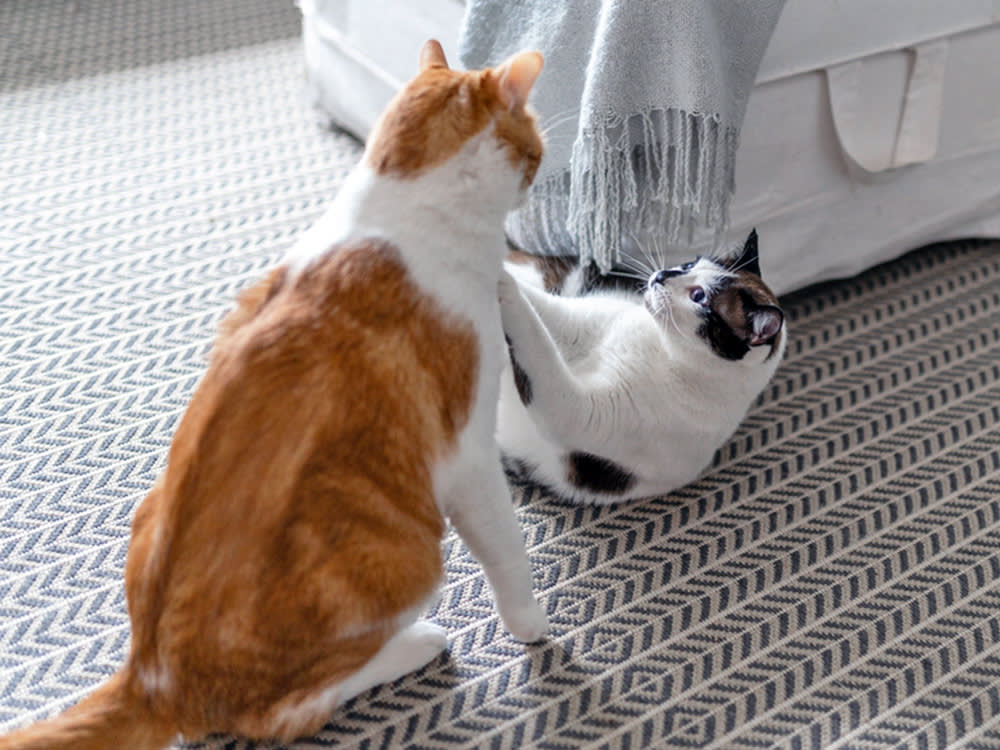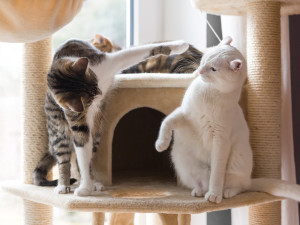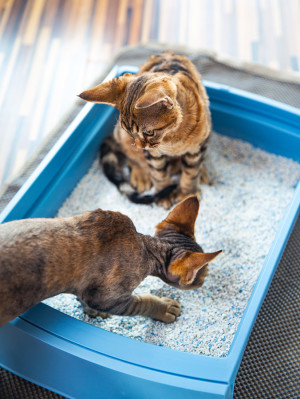Recognizing Red Flags: Essential Warning Signs When Introducing Cats
And how to avoid any problems.

Share Article
In This Article:
How to Introduce a Cat to Another Catopens in new tab Warning Signs When Introducing Cats to Other Cats Managing Conflict
Challenging cat introductions are among the most common issues I see working with clients. That’s because cats aren’t designed to meet stranger cats and be friends. Instinctually, most cats (though not all) will fear for their safety and resources when another cat shows up.
If they’re suddenly expected to live together, it can cause stress, aggression, house soiling, fear, and other behavior and quality-of-life issues. That’s why it’s worth taking your time and doing it right. With a slow, careful, and positive introduction process, you’ll have the best chance of helping your resident cat and new cat learn to coexist. A vital part of that process is knowing what to look for when things aren’t going well.
How to introduce a cat to another cat
Introducing one or more cats to another cat can be a bit involved. We’re going to share the basic steps here and focus on catching and addressing potential problems.

The most important thing to remember is that you never want to push either cat past their comfort zone. This is one of the main reasons introductions go sideways. They’re rushed, or the cats are expected to take really big steps. Instead, you want to find a starting point where the cats feel secure and relaxed. Then, you’ll gradually move through the introduction baby steps, watching for even the tiniest body language cues that one of the cats is feeling stressed. We’ll cover those body language cues later in the article.
There’s no set timeline for any of these steps. The cats tell you when they’re ready to move forward or need you to slow down. Follow their lead.
Scent before sight
Your cats should be separated initially, with no visual access. You’re starting with scent work. Place a piece of fabric in each cat’s favorite sleeping spot. Let them lie on it for the day so it smells like them. Then, move the fabric into the other cat’s area.
Don’t put it in the other cat’s bed. Just place it in a room where they spend time. Put a treat on top so they’ll connect the other cat’s scent with something they love. After a couple of hours, the fabric returns to the original bed so it can get re-scented and swapped again the next day.
You can also start group scent work. Use a clean cotton sock to rub one cat’s cheeks and shoulders. Take that sock to the other cat and let them sniff it. If they’re OK with the scent, treat them and rub the same sock on their cheeks and shoulders. Then take the sock back to the first cat, let them sniff it, treat them and rub the sock again on their cheeks and shoulders. They now share a group scent.
If either cat is uncomfortable with the scent on the sock, don’t force it. Just drop the sock near them with a treat on top and try again the next day. Bedding swaps and group scent can be done daily through the first few steps, then every couple of days through the last few steps.
Swapping or rotating spaces
When the cats are doing well with the scent work, you’ll start giving your new cat access to the rest of the home while your resident cat is secured in a separate room.
If you don’t have a separate room for your resident cat, you can swap them. In this scenario, the new cat is let out of their room, and the resident cat goes into the new cat’s room. Just be aware this can be stressful because the resident cat is now surrounded by the new cat’s scent with no way out, and the new cat is locked out of their safe space. If it’s too stressful, keep these swaps short and positive until they feel more secure.
Barrier work
When the cats are doing well with each other’s scent, and your new cat is starting to feel secure exploring the rest of the home, start barrier work.
First, you’ll need a barrier the cats can see through, that you can cover with a sheet or blanket. Stacking two or three baby gates works well. You can also install a screen door or something similar.
Barrier sessions will be short. You can do them once a day or more. The cats will focus on something positive throughout the session. I don’t recommend using their meals for this. Instead, try treats, petting, catnip, mild play, brushing, or other mellow things they love.
Start with the barrier completely covered so they can’t see each other. The cats should be far enough apart that they have no reaction to each other. They focus on their positive thing without worrying about what’s happening across the barrier. When the session is done, close the door so the cats can’t access each other.
Every couple of sessions, if things are going well, move the cats closer together on either side of the barrier. Stop when they’re about five feet apart. Now, you’ll gradually uncover the barrier. Do this over many sessions, uncovering just a few inches every few sessions while the cats focus on their positive thing.
When the barrier is fully uncovered, and the cats are doing well, you can do longer handout sessions at the barrier. The cats still get to focus on something positive as needed. You can increase the length of the sessions and let them move a bit and do their own thing. They’re getting used to each other with the protection of the barrier, space between them, and something positive you can use to pull their focus away from each other when needed. You still want them to be nice and relaxed. If they’re tense or fearful, they’re not ready for this step.
Then, you’ll go back to shorter sessions, having them fully focused on their positive thing while you start opening the barrier. Just like the uncovering step, do this gradually over multiple sessions.
Sharing space
The last step is doing short, supervised sessions where the cats share space. Pick a neutral room where they both feel comfortable. Set up their positive activities on opposite sides of the room. Over multiple sessions, you can slowly move them closer together and increase the length of the sessions.
When you feel ready, you can pull back on the positive things holding their attention and start letting them do their own thing, always watching for tense moments where you’ll want to pull their focus back to something positive. When they’re doing well here, you can try letting them hang out unsupervised and, when ready, full-time.
Warning signs when introducing cats to other cats
Body language will tell you when the cats are outside their comfort zone and you need to reduce the intensity.
Big body language cues
When a cat is hissing, growling, swatting, or showing obvious signs of fear or aggression, that’s their way of yelling, “No!”
This cat is way past their comfort zone. End the session right away and think about how you can turn the intensity way down for next time. You won’t make progress if your cat is this scared.
Subtle body language cues
Cats usually show much more subtle signs before they get to the big stuff. This is what you want to watch for as your cue to turn the intensity down before things get serious:
Unwilling to focus on treats, petting, or other positive things
Staring intensely
Trying to look larger or smaller
Ears turning, even a little, to the side or back
Fidgeting
Tail going from a calm or casual swish to a more agitated swish or flick
Twitching skin
Licking the lips
Any posture that looks more tense than relaxed
Managing conflict
If your cat shows any of the warning signs above, things are too intense. You can turn the intensity down using one or more of the following, and move forward more slowly, always keeping positive reinforcement part of your approach. Keep stress reduction in mind as you do the following:
Back up to a previous step.
Put more distance between the cats.
Limit how much they can see each other (cover more or all of the barrier).
Shorten the length of the session.
Increase the value of the positive thing they’re focused on (like using a special treat instead of an everyday treat).
Remember, it’s not about keeping your cats in a step until they calm down. It’s about moving slowly enough that they’re not feeling stress or fear. If they do, they’re not ready for that step. Back up and turn the intensity down.
FAQs (People also ask):
Why are my cats jealous of each other?
It’s often not so much about jealousy as it is competition for resources that makes it appear your cats are jealous of each other. You can be a resource for your cat, just like food, water, and a clean litter box. Competition for any key resource can cause stress, tension, and even aggression until the cats understand there’s enough for everyone and they’re not in danger. That goes for your time and attention as well.
Why is my new cat aggressive toward my resident cat?
This is a natural, instinctual behavior cats have learned over thousands of years. It’s a way they protect themselves from physical danger and loss of resources, like food and water, to a stranger. Going through the introduction process shows them they aren’t in danger. Making sure they have plenty of resources spread throughout the home shows them they will continue to have what they need to survive.
How do you introduce a cat to another pet?
There are several steps you need to take to introduce your cat to another pet; please follow this guide to help you get started.
Will my cats just get used to each other with time?
Some cats may start to feel more secure with each other given time. But there’s no guarantee, and it will be pretty stressful for you and them in the meantime. It’s usually better to go through a careful introduction process to show them they have nothing to fear and build positive associations with the other cat’s presence in the home.

LeeAnna Buis, CFTBS, FFCP
LeeAnna Buis has adored cats her entire life and thought she knew them inside out and sideways. But it wasn’t until she worked with a feline behavior consultant that she fully understood how incredible, complicated, and inspiring they really are. She made a career change, starting the certification process to become a behavior consultant right away. She discovered what unique, fascinating, complex creatures cats are and knew this was what she wanted to do with her life — help others on a similar journey to truly knowing, loving, and appreciating their cats.
LeeAnna earned her certification through Animal Behavior Institute, where she received the certified feline training and behavior specialist (CFTBS) designation.
Related articles
![Black cat staring at a cat toy]()
How to Play With Your Cat
Cat behaviorist Cristin Tamburo’s got a game plan.
![Woman playing with her cat.]()
Your Cat Really Wants You to Play With Them—Here’s How
It’s the key to a happy cat.
![cat hissing under chair]()
Cat Hissing: Fair Warning or Fighting Words?
Your cat’s hissy fit could mean Don’t test me or Let’s do this. We wouldn’t call their bluff.
![cat biting person's hand]()
Why Does My Cat Bite Me?
Don’t live in fear of your feline overlord.
![two cats sharing litter box]()
Can Cats Share a Litter Box?
The better question is should they?
![An angry and hissing Siamese kitten standing on top of a laptop computer in the living room]()
You Don’t Have to Live Like This—You Can Get a Trainer For Your Cat
Tips to help you find a legit behaviorist (according to a veterinary behaviorist).









